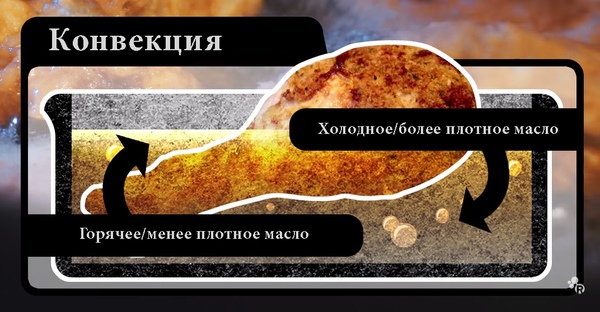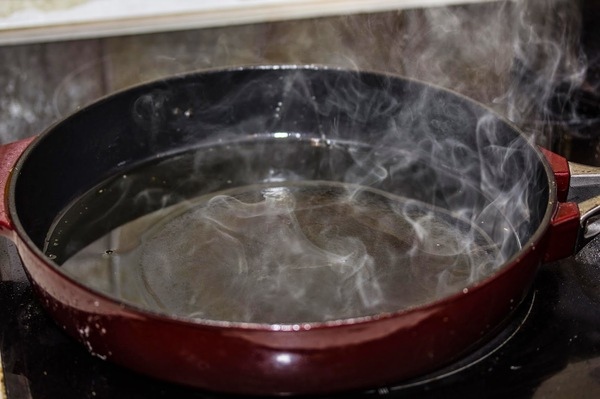Chemistry of fried chicken. Detailed analysis
For many, deep-fried chicken is one of the most delicious dishes, albeit not the most healthy. What makes it so tasty?

The thing is the behavior of the oil at high temperatures, namely, the ongoing chemical processes. In this case, we are talking about the complete immersion of chicken in deep fat, and the oil temperature in this case reaches 150 - 190 C.
The first step is the convection process - the heated oil rises from the bottom to the surface, and the colder, respectively, into the lower layers, thereby ensuring a uniform temperature.

Then, according to the principle of thermodynamics, heat diffuses from the heated oil into cold chicken. In the process of frying, a kind of foam can be seen in the meat. It is moisture coming out, and by no means boiling oil.

In fact, she has a very important role:

Hydrolysis is the interaction with water, during which decomposition of a substance occurs. In this case, triglycerides, the fats that make up the oil, interact with the released moisture. As a result, they break down into free fatty acids, glycerin and monoglyceride.

This process is essential in frying any product. In addition, the marinade and chicken skin during this process are made crispy and delicious. But due to the increase in the amount of fatty acids in the oil, hydrolysis is becoming slower, and fatty acids, being oxidized, make the oil "waste." This oil turns brown, there is an unpleasant smell of products of harmful fatty acids and even smoke. For this reason, you should never use this oil for re-frying.

Oxidation - in this case, the interaction with air oxygen of the resulting fatty acids with the release of volatile products, and as a result of the previously described unpleasant odor. The composition of volatile compounds depends on a particular fatty acid; it can be aldehydes, ketones, a variety of hydrocarbons, and more.

For this reason, chicken should be deep-fried: it is completely immersed in oil, and the air does not reach the surface of the meat from which fatty acids are formed. And if there is no oxidation process, then there is no unpleasant odor and it is possible to cook longer in oil.

Also, if you add spinach or ginseng to the marinade, you can reduce the oxidation process, since they contain antioxidants (vitamins A and C), and as a result, keep the chicken taste good.

The taste provides, in addition, the result of the third process: due to the high temperature, free fatty acids are able to polymerize (to form long polymers by attaching molecules to each other).

Polymers can accelerate the degradation of oil and give the chicken a specific flavor of fried meat. The polymerization is accelerated by an increase in temperature, but it also accelerates the process of acid oxidation, so you should not overheat the oil too much. If you can control the temperature, then the best option for deep fat 168 C.

This is not to say that deep-fried chicken is a healthy food, you should never abuse anything, but nevertheless, following the tips described above can significantly reduce the harm from heavy foods and enjoy the juicy taste of fried chicken.

The thing is the behavior of the oil at high temperatures, namely, the ongoing chemical processes. In this case, we are talking about the complete immersion of chicken in deep fat, and the oil temperature in this case reaches 150 - 190 C.
The first step is the convection process - the heated oil rises from the bottom to the surface, and the colder, respectively, into the lower layers, thereby ensuring a uniform temperature.

Then, according to the principle of thermodynamics, heat diffuses from the heated oil into cold chicken. In the process of frying, a kind of foam can be seen in the meat. It is moisture coming out, and by no means boiling oil.

In fact, she has a very important role:
- firstly, moisture creates a “vapor barrier” which prevents the chicken from being too saturated with oil;
- secondly, thanks to it there are three important chemical processes: hydrolysis, oxidation and polymerization.

Hydrolysis is the interaction with water, during which decomposition of a substance occurs. In this case, triglycerides, the fats that make up the oil, interact with the released moisture. As a result, they break down into free fatty acids, glycerin and monoglyceride.

This process is essential in frying any product. In addition, the marinade and chicken skin during this process are made crispy and delicious. But due to the increase in the amount of fatty acids in the oil, hydrolysis is becoming slower, and fatty acids, being oxidized, make the oil "waste." This oil turns brown, there is an unpleasant smell of products of harmful fatty acids and even smoke. For this reason, you should never use this oil for re-frying.

Oxidation - in this case, the interaction with air oxygen of the resulting fatty acids with the release of volatile products, and as a result of the previously described unpleasant odor. The composition of volatile compounds depends on a particular fatty acid; it can be aldehydes, ketones, a variety of hydrocarbons, and more.

For this reason, chicken should be deep-fried: it is completely immersed in oil, and the air does not reach the surface of the meat from which fatty acids are formed. And if there is no oxidation process, then there is no unpleasant odor and it is possible to cook longer in oil.

Also, if you add spinach or ginseng to the marinade, you can reduce the oxidation process, since they contain antioxidants (vitamins A and C), and as a result, keep the chicken taste good.

The taste provides, in addition, the result of the third process: due to the high temperature, free fatty acids are able to polymerize (to form long polymers by attaching molecules to each other).

Polymers can accelerate the degradation of oil and give the chicken a specific flavor of fried meat. The polymerization is accelerated by an increase in temperature, but it also accelerates the process of acid oxidation, so you should not overheat the oil too much. If you can control the temperature, then the best option for deep fat 168 C.

This is not to say that deep-fried chicken is a healthy food, you should never abuse anything, but nevertheless, following the tips described above can significantly reduce the harm from heavy foods and enjoy the juicy taste of fried chicken.
All Articles